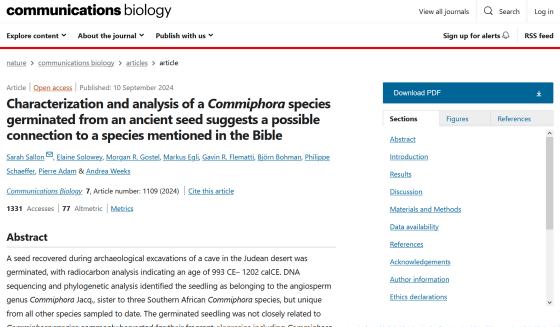Mysterious Desert Seed Growing Tree May Be 'Lost Bible Tree'

Scientists have succeeded in germinating a 1,000-year-old seed found in
Characterization and analysis of a Commiphora species germinated from an ancient seed suggests a possible connection to a species mentioned in the Bible | Communications Biology
https://www.nature.com/articles/s42003-024-06721-5

Lost Biblical tree resurrected from 1,000-year-old mystery seed found in the Judean Desert | Live Science
https://www.livescience.com/planet-earth/plants/lost-biblical-tree-resurrected-from-1-000-year-old-mystery-seed-found-in-the-judean-desert
In the late 1980s, archaeologists from Hebrew University excavating in a cave in the northern Judean Desert recovered an unidentified seed. The seed was about 1.8 cm long and weighed 0.565 g. It had been preserved in the Hebrew University's archaeology department for a long time, but an Israeli research team decided to try cultivating it.

When cultivation began in a greenhouse at the Center for Sustainable Agriculture in Israel in 2010, the seeds germinated five weeks after being planted.

The specimen was named 'Sheba' and has been cultivated for over 10 years. Here's what Sheba looks like 12 years after the seed was planted. At the time of writing, Sheba is 14 years old and less than 3m tall. Radiocarbon analysis of the wood has shown that the seed dates back to between 993 and 1202.

The bark is a pale greenish brown, and the thin, papery sheets of bark peel away to reveal the dark green stem. DNA analysis has determined that Sheba belongs to the genus Commiphora, which belongs to the family Burseraceae in the order Sapindales . The genus Commiphora is found primarily in Africa, Madagascar, and the Arabian Peninsula, and is the same family as myrrh, which was used as incense in ancient Egypt.

The exact species to which Sheba belongs is unclear because it has not yet flowered and scientists do not yet have access to reproductive organs for more detailed analysis, but it is known to be weakly related to more fragrant species such as the Arabian balsam (Commiphora gileadensis) and strongly related to three species found in southern Africa.
The team initially suspected that Sheba was a fragrant tree called 'Judean Balsam' that was cultivated in the region in ancient times, but this hypothesis was rejected due to the lack of aromatic compounds in Sheba. Instead, Sheba was rich in compounds with anti-inflammatory and anti-cancer properties, and its leaves and stems were also rich in squalane, an oily substance with antioxidant and skin-smoothing properties.
These findings lead the team to suggest that Sheba may not be the identity of the Balsam of Judea, but rather the tree that produces the biblical resinous extract 'tsori,' which is associated with healing in the books of Genesis , Jeremiah , and Ezekiel .
'The results of DNA sequencing, phylogenetic and phytochemical analyses, in conjunction with historical, archaeological and phytogeographical data, suggest that 'Sheba' may represent an extinct species of the Myrrha genus that once grew native to the region. This species once grew native to the region, and its resin extract, 'tsori', is mentioned in biblical texts. It was thought to be a valuable substance associated with healing, but these texts do not mention it having an aroma,' the team said.
Related Posts:







